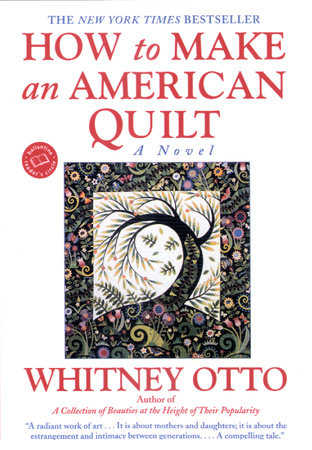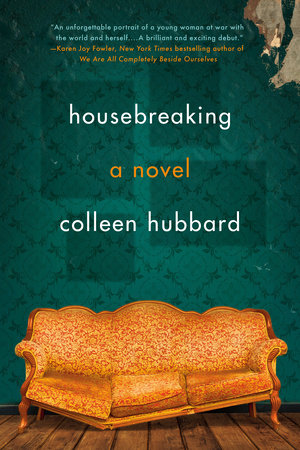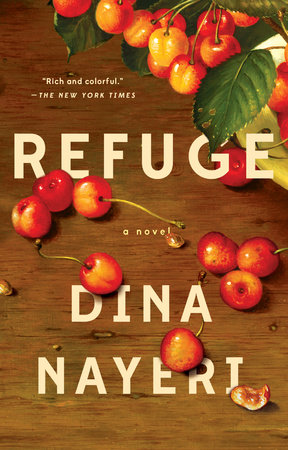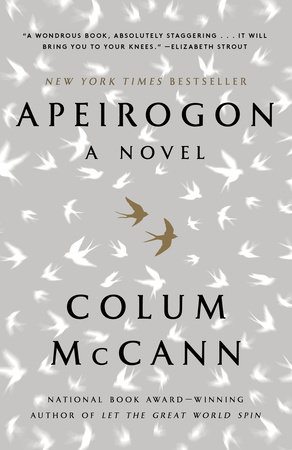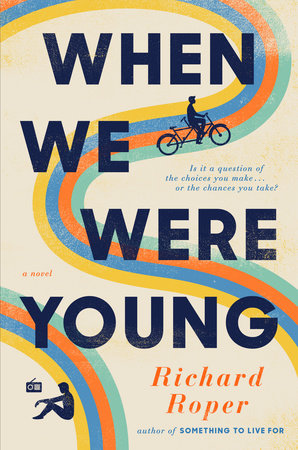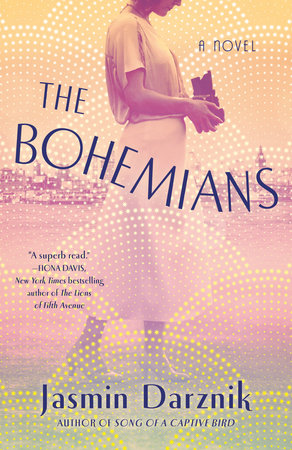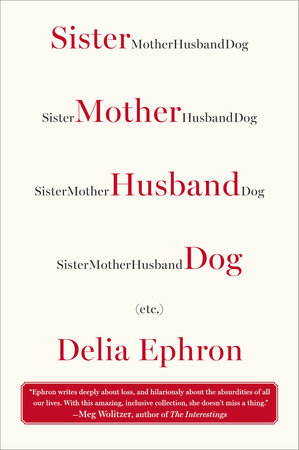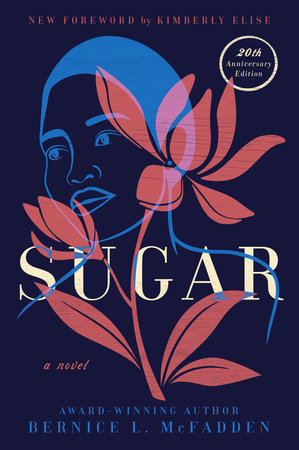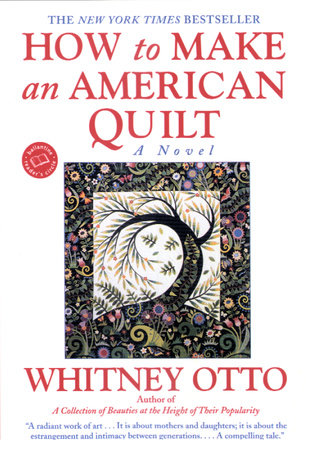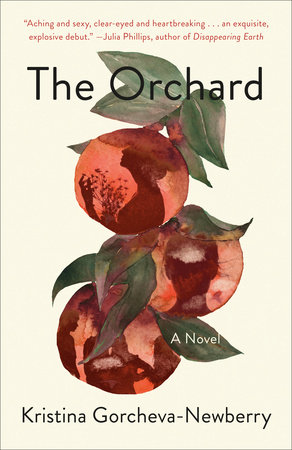Author Q&A
A Conversation with Whitney Otto
Diana Abu-Jaber is Writer-in-Residence at Portland State Univer- sity and author of the novel Arabian Jazz .She is also a food writer who frequently dines with Whitney Otto .
Diana Abu-Jabar:The quilt and the making of quilts forms a central motif in your novel.Tell us about how you came upon the idea of quiltmaking for the book and why you decided to use it.
Whitney Otto:I was in a two-year graduate writing program at UC Irvine and during our summer break we were expected to con- tinue writing in order to have something to give the workshop when the term resumed.I had had a very lazy summer and waited until the last minute,so that when I did finally sit down to write,I really had no idea what I wanted to write about.As I sat at my typewriter,I found myself writing this story title "How To Make An American Quilt "before promptly going back to trying to think of something to write about.There I was,working to come up with something,anything,and in the meantime sort of putting down this quilt story as a way of attempting to jumpstart an idea. By the end of two days I had a 24-page short story called "How To Make An American Quilt,"which reads like an abridged version of the novel.And the thing is that even when I had finished this short story –that I didn ‘t want to show to my teacher because I thought he would think it lightweight and make remarks about the ways in which I spend my time –I was still worrying about what to write about.
As I was worrying about whether to show the story to anyone,that very teacher,Don Heiney,called my home (something he never did)and asked what I had written over the summer.I said I did have this one short story."Good,"he said,"Bring it by my house sometime today and I will read it tonight."Though this was not in my plans,I reluctantly did as he asked.
That night he called again,excited,telling me that he hadn’t seen anything quite like my story and what did I think about turning it into a novel?It was,I have to say,a pretty wonderful moment and about a year later I did make it into a novel,though not in the way he suggested.I wrote the story in 1988,and the novel in 1989.
DAJ:How did you do the background research?Have you done any quiltmaking yourself and did you enjoy it?Have you ever belonged to a quilting circle?
WO:Since I knew nothing about quilting,but knew what I wanted to do novelistically,I had to fill in the blanks with re- search.However,since I was writing a story I did not want to do rigorous,academic type research –I wanted something lighter, more anecdotal –so I went to a store that sold quilts,bought some books with pictures of quilts and a little basic information.None of the books were how-to books.
I don’t quilt.I don’t even sew.In junior high I ended up taking home ec.not once,but twice.And I still ended up bringing home one of those little pink slips to my parents saying that I was not doing passing grade work,primarily in sewing.
I mistakenly believed that there was maybe 5000 quilters in this country,that it was some sort of incresingly rare art.Clearly,I had no idea how popular and thriving quilting is.After the book came out,I met my first quilters,went to my first quilt shows and was fairly amazed by the entire culture of quilting.
The thing that drew me to the subject has a more writerly genesis: prior to writing the short story that became the novel,I had often constructed my stories in a kind of collage form.Why?I don’t know,but that was simply my inclination as a writer.So,I think the idea of something that was a collage form (a quilt),that could be taken apart and reassembled and taken apart and reassembled interested me.The structure of the book reflects the structure of a quilt (it is a word quilt,actually),and quilting was an activity that bound the character’s stories,as well as the characters them- selves together,and it worked metaphorically.For me,much of the book is about the contradictory needs for company and soli- tude.It is also about a group of women –who are not necessarily friends –meeting once a week to make art.
DAJ:The novel plays with point of view and perspective, sometimes switching between characters,and in several sec- tions,the narrative refers to "you."How did you decided to construct this point of view?
WO:As I mentioned,the collage approach was one that was natu- ral to my storytelling,and I found a single point of view too limit- ing for what I wanted in this book.It seemed,too,more in keeping with a quilt to have multiple points of view.As for the "you "–I was trying for an "instructional "tone,to set the voice apart from the women ‘s voices in the story.
DAJ:Even though there ‘s a good-sized cast of primary charac- ters,would you say this novel really belongs to one character or do you feel its evenly shared?
WO:I feel it ‘s evenly shared.Because the opening is in the first- person voice of Finn Bennett-Dodd,the reader may perhaps feel she is telling this story.But almost immediately the instructional voice takes over,then each character’s consicousness is inter- spersed.The small end piece moves back to Finn,but this time we see her driving with Anna and asking her questions,so one could then presume that the whole story is told by Anna to Finn. The other thing the ending does is to lead the reader directly back to the beginning;it is not an opened ended story end.It is circular rather than conclusive.
DAJ:Why did you construct the book about an ensemble cast rather than one primary character?
WO:Because I wanted that quilt feel,and because,as I said,that is my narrative tendency.
DAJ:Even though so much of the story is about friendship,the notion of transgression and betrayal comes up frequently in the story,from the elderly sisters smoking pot to the large scale betrayals that these friends and colleagues perpetrate against each other.Are you particularly interested in the no- tion of betrayal?
WO:Yes,actually.Maybe this is a good time to say that I’m not sure writers choose the themes or ideas or subjects that they end up putting on the page.That said,for me,notions of friendship, love,trust,and betrayal compel me because it is so hard to be true in this life,because life is complicated and most of us are (often movingly)flawed.An ideal coming into contact with the real.The writer James Baldwin says "I think …that the finest principles may have to be modified,or maybe even pulverized by the demands of life,and that one must find,therefore,one’s own moral center and move through the world hoping that this center will guide one aright."
Another way to look at it is that the men in the book are not espe- cially villanous –nor are the women virtuous.For example, Sophia’s husband’s disappearance (after 20 years together)is a response to Sophia ‘s inflexible manner as well as her belief that men leave.Or,as painful as it is for Glady Jo when her husband sleeps with her sister,Hy,Arthur truly does want Hy,on some level,to be Glady Jo.Even a man like Dean,the selfish artist,is simply frustrated by his lot in life –which most people in a cre- ative field can relate to –yet his wife,Em,is the one who feels the fallout from his infidelities.And so on.
A fall from grace does not contradict a deeper goodness.It is part of being human,and for my characters,they might misstep,but then they try to find that grace again.At least,that is how I see them.
DAJ:In an attempt to deal with her feelings,one of your char- acters uses broken fragments of china to create a sort of mo- saic or collage on her walls.Where did you come up with the idea for this?
WO:Someone suggested to me that this was similar to the works in the 1980s by Julian Schnabel –whom,I am embarrassed to say, I had not heard of at the time I wrote this book.Actually,I think I had read some kind of human interest piece in a magazine about a man who had affixed seashells all over the walls of his house.So when Glady Jo and Arthur’s house was stewn with the wreakage of her wrath,it came to me that the shards of broken objects would look good on the walls –and be weird,as well.Disquieting.It also worked with the central idea of the quilt,that is,coming apart and reassembling.It mirrored the collage aspects of the novel it- self as well.It seemed that it was a physical manifestation of sal- vaging a broken marriage;a way of not leaving it,though it is now existing in another,different form.
DAJ:Several of these characters –particularly the older women –are forced to confront the difference between their private desires and the cultural norms of their generation.Do you think that this sort of restriction on women’s indepen- dence has relaxed?Are women today better able to follow their dreams?
WO:Yes.I think there have been enormous strides for American women in my lifetime.It is reflected in education (more women with college degrees)and in the work place (in a greater variety of professions,including politics),though there has been a some aspects of a feminist backlash.If anything,going to a woman physician,for example,is not unusual,but the idea of a woman president is still a novelty.And to some extent women still have to work harder,to prove something.The playing field isn’t en- tirely level yet,but,it is better than it was for my mother’s gen- eration in terms of pursuing one’s dream.It is just that women’s issues –because some of the larger elements have changed –have become more refined,more complex.It still is not over.
DAJ:There ‘s a directness to your writing that doesn’t shy away from making clear statements about the experiences of these characters.Does this sort of approach violate the old writing axiom "Show,don’t tell?"Do you think of yourself as an opin- ionated writer?
WO:There is no end to my opinions on everything!!!It is a fine line between not trusting the reader (giving into the urge to spell it all out,as it were)and simply offering up the story,allowing it to be understood or interpreted according to the whim of the reader.I do like a good pronouncment now and then –and even if it is what I believe in my non-writing life –I try to keep it within the realm of the story and the character.If a character makes a statement,it might sound like something I say,but it would be a mistake to make that assumption,because it might be what I believe –or it might be what I believe,say,in the guise of the character only.But,you know,it is a misconception that anyone can write if they just have a story;that there is no craft involved at all,that no choices (words,structure,plot,what to keep and what to delete)are being made.Most writers write because they have something to say,not just a story with nothing underneath. Often they say what they want to say through the story;another old axiom,"Fiction is the lie that tells the truth."
DAJ:How to Make an American Quilt is very much immersed in the investigation of women’s lives and relationships.Do you think of it as a feminist book?
WO:To a certain extent,it is a feminist book because it is talking about women’s lives;the men really exist more on the periphery. But then,is a novel that focuses on men with women at the pe- riphery a man ‘s book?One that does not touch on the universal experiences for men and women?I feel that this book has as much for men as it does for women,and that it too deals with universal themes and ideas.Or,even if something I read could be construed as a man’s book,why shouldn’t I read it anyway?Part of the pleasure of reading is being different people,going different places,looking at the world in a different way.I think most true readers –who really love to read –tend to read all over the place anyway.
Still,this has always been a hard question for me because I have often said that I would like to be considered an American writer, or just a writer,and not a Woman Writer (though I certainly am that and don’t want to distance myself from it).Men are not called male writers –they are just writers,and I think women who write should be offered the same consideration.If for no other reason than because,in this country anyway,if we label someone a woman writer,it seems to allow people to subtly dismiss her work.To say,it is good for what it is,that is,womens fiction.And I really feel there are only books one loves and books one doesn’t love,not books that are masculine and feminine,and that one (masculine)type covers grand themes,the state of the world,and one’s soul,while the other (feminine)is only concerned with the small disturbances of the domestic sphere.Let me say here,the disturbances of the domestic sphere are not lesser events,nor are they small.
DAJ:Why did you choose to conclude the novel with the story about Marianna,the young woman of mixed race?Did her story have particular significance to you?
WO:Marianna ‘s story was a natural conclusion because she is the youngest in the circle,so chronologically it made sense,and be- cause race and class (economics)are the American story in many ways.America is supposed to be the classless society –though we know it isn’t.And throughout the book there are historical refer- ences to race (specifically white and African-American)and the idea that one race cannot be looked at or thought of separately from the other.We are all Americans,we are all in this together.
And I don’t mean that in a Pollyanna,melting pot manner;I mean the relationship has,historically,been a fraught and diffi- cult one all around,but we are part of each other absolutely.
Not focussing on the other groups that are also American and also have an unjust history was a novelistic choice I made.I am a fiction writer,not a historian (though I do have a degree in his- tory);I’m not writing a treatise;so finally,all the things that went into this novel were made with regard to the demands of the story.(Again,the craft of writing:Flaubert wrote something to his mistress Louise Colet that I have always liked.He said,"One must not think feeling is everything.Art is nothing without form.")I don ‘t believe this book to be a definitive story of America;it wasn ‘t meant to be –that is why it is "an American quilt " and not "the American quilt."
DAJ:Do you believe it’s true that "the best men cook for you?"
WO:Well,you know,the way to a woman’s heart is through her stomach …
